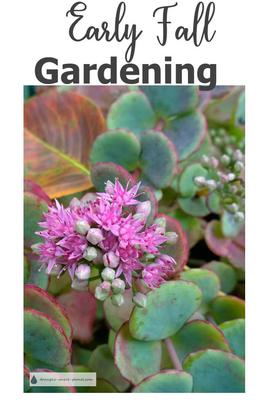by James
(UK)

Fall Succulents
The growing season is winding down but there are still some important tasks to take care of to ensure a healthy, thriving xeriscaped landscape in the spring. Don’t neglect the gardens now that summer is over. In fact, now is the perfect time to get started on some tasks that will make the spring chores go much easier.
Succulent Care
The majority of succulents need a dormant period in order to flower the next season. In their natural habitat, winter is the dry season and the succulents are accustomed to enduring lengthy periods without water.
- Reduce watering to about once a month, letting the soil dry out completely before watering.
- Place the plants in a place where they will be sheltered. A greenhouse is nice for this. Alternately, cover them with garden fleece to protect them from frost and cold.
- Remove any dead leaves or branches.
- Trim overgrown plants.
- Inspect for pests and deal with any infestations before the dormancy starts. Healthy plants will prevail through winter temperatures best.
There are some varieties that are the opposite and flower in the winter instead of the spring. Double-check which types you have. Those that are winter-blooming will still need regular water and warmth.
Mulching
To reduce the need for water, add another layer of mulch around your plants. The mulch layer should be about 10cm. Mulch also moderates soil temperature and keeps weeds at bay, making the garden much easier to maintain. During the winter, the mulch will prevent the soil from repeatedly freezing and thawing and distressing the plants.
Choose an organic mulch so that when it decomposes, it adds richness to the soil instead of chemicals. Using a good mulch is a great way to build soil and increase overall soil health.
Plant More!
Fall is the best time to add more plants to a xeriscape garden because it gives them time to establish themselves and develop strong roots. Choose drought-tolerant plants that are native or naturalized to your area.
Group plants based on water needs so that caring for them is easy and efficient. The time from planting to colder winter temperatures is needed to prepare the roots is important.
If possible, put new plants in the ground as opposed to containers. With a nicely mulched landscape garden, the soil will protect and warm the plants better than if they are in containers.
Arranging plants near rocks or boulders will give them more sunlight and protection during the long winter months. South-facing structures will also protect them.
Dividing and Transplanting
Perennials that have gotten too big should be divided and transplanted to new areas.
The fall is the best time for this because the blooms have died back and you can see all the plants clearly.
It may be that you don’t even need to buy new plants for the landscape because you have enough from the dividing. Shrubs should be examined, as well, to see if there are any new starts that can be moved to a better location. There is nothing quite like “shopping” in your own garden to plant a new garden.
Weed Now to Weed Less Later
It would be nice to be done with weeding, however, the fall is the best time to weed for next year. All those weeds, if left, will go to seed and happily produce many more weeds come spring. Remove all parts of the weed, root and all, to ensure they will not take hold once winter is over and cause you a whole new slew of problems.
James at Garden DIY blogs bout various gardening topics including helpful guides on choosing the best gardening tools as well as how-to articles on growing your own plants and vegetables.


